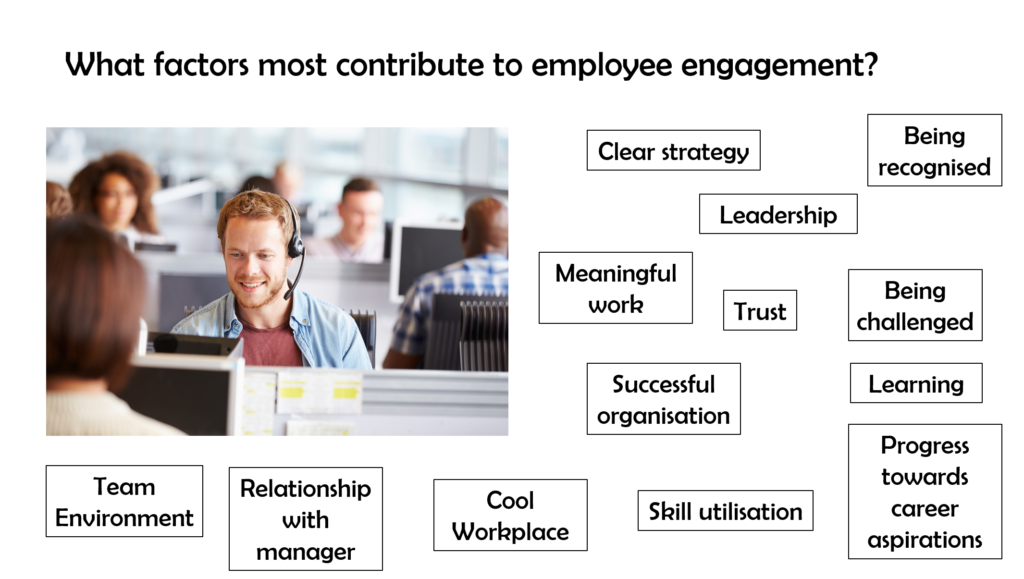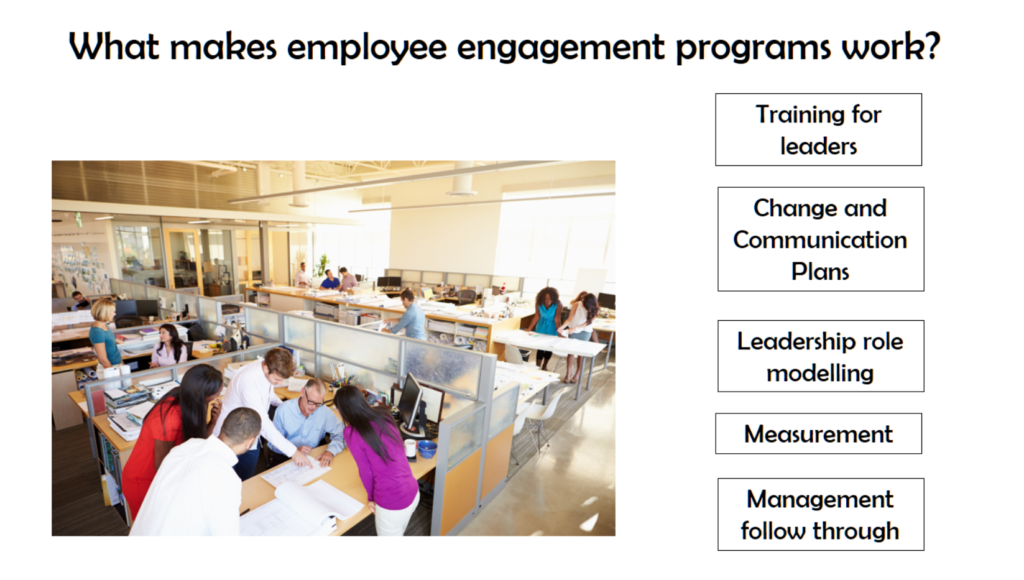Formalised programs are often used to enhance employee engagement in large organisations. These programs typically involve employee surveys, communication activities and action planning. It is hoped these undertakings will identify where changes can be made to improve employee engagement and to facilitate those changes. It is also hoped that as engagement increases, so too will business performance.

It’s a big ask…
…not least because employee engagement is a complex concept with actions requiring an appreciation of human behaviour and motivation, team climate and organisational culture.
I’ve been interested in employee engagement for a while and have been chatting with human resource colleagues about their experiences in supporting employee engagement initiatives. Human resource practitioners and corporate communication teams typically carry responsibility for delivery of employee engagement programs. Because of this, I was interested in obtaining their insights into:
- What employee engagement was?
- What factors most contributed to employee engagement?
- What were the biggest drivers of disengagement?
- What were the biggest obstacles to increasing engagement?
- What support or resources were critical for success?
- If they had to do it again (‘it’ being a large engagement program), what would they do differently?
- What things most influenced their own engagement?
They gave me rich perspectives in each area. A synthesis of what they shared follows.
1. What is employee engagement?
There isn’t agreement about employee engagement.
Some felt that it was the connection between the employee and the organisation – indeed a measure of the extent to which an employee believes in the purpose and strategies of the organisation. Central to this was an employee’s understanding of how they contribute to the vision, and being motivated to support this vision. One respondent described ‘feeling committed’ to the organisation as an indicator of engagement.
Another colleague declared they weren’t a fan of the term and observed that no one had worked out what employee engagement was, adding that they did not feel that the term added anything more to what was already known about intrinsic motivation. This sentiment is reflected in the academic literature as well with suggestions that employee engagement is a repackaging of older concepts such as job satisfaction and organisational commitment, also drawing heavily on Bandura’s (1977) work on self-efficacy. (Self-efficacy refers to an individual’s belief in their capacity to execute behaviours necessary to produce specific performance outcomes).
It’s a two-way process
Others described employee engagement as a two-way process, where there is genuine and meaningful communication and alignment between an individual’s values and those of the organisation. Further, employees feel that they belong, with their personal identity intrinsically connected to the organisation. However, this relationship is fluid and subject to change.
Positive feelings and behaviours are a sign
When employees are engaged, they apply discretionary effort and are more productive. Going the extra mile is effortless and done with passion and pride. At the same time, they experience a sense of joy and satisfaction in their work. Being engaged was also described as a time when employees’ hearts and minds were absorbed in their work.
Can be a full or partial experience
Engagement is not an ‘on or off’ experience. Indeed, an individual can be engaged in a task, say if it is highly stimulating, while at the same time, not feeling a sense of engagement towards their team. Similarly, employees may feel a strong sense of attachment to their local work unit with lesser feelings of connection towards the organisation.
2. What factors most contribute to employee engagement?

Trust
A work culture that is built on trust and autonomy. Without trust, employees see engagement activities as ‘lip service’. To achieve trust there needs to be mutual respect and a strong psychological contract between the parties. How an employee is managed day to day, will have a bearing on this as well as how inclusive the organisation is.
Clear Strategy
The starting point of an employee engagement program is a well-articulated strategy that makes sense. Without a clear strategy and excellent leaders, it is difficult to achieve employee engagement – even if you have world class HR professionals, programs and systems.
Leadership
Leaders being open, transparent and authentic. It was noted by one respondent that so few things require leadership secretiveness.
You then need the best leaders possible, particularly in senior roles. Leaders articulate strategy, motivate teams and stretch them to achieve their goals.
Leadership includes receiving candid and constructive feedback through the employee engagement program and ensuring it’s responded to. A line manager who ‘has my back’ and supports me.
Successful organisation
Is my organisation successful? If not, do I believe it can be?
One size does not fit all
One size does not fit all and individuals will be motivated by different factors. These factors shift as we age and mature.
Using their skills and learning
Having the opportunity to learn from my line manager, from my peers and from my team. Feeling stretched and involved in tasks and projects that ‘make a difference’. Enabling employees to use their skills and knowledge and allow failure without repercussions.
Being recognised, appreciation and feedback
Do I believe that my bosses, appreciate my efforts and contribution?
When employees feel valued and are acknowledged for their expertise and contribution – they are engaged.
Being challenged
Being challenged is central to engagement for some, while for others, just doing their jobs well, is enough.
Meaningful work
Several characteristics were suggested as inherent within meaningful work. For example, ‘Am I doing something I enjoy? Am I making a difference?’
Development and career advancement
Ongoing learning was a common theme. Gaining experience, knowledge, education and/or exposure should help me grow towards my career and life aspirations. Opportunities for development, whether on the job or as part of a career path.
Team environment
What’s my team environment like? Do I enjoy the people I work with?
Relations with my manager
Do I like my boss?
‘Cool’ Workplace
Am I inspired by my workplace, i.e. the people and the environment?
Is there a ‘cool’ factor? (This was mentioned as being relevant for younger workers and for older workers – more than was sometimes realised).
3. What are the biggest drivers of disengagement at work?
There was a long list of responses which I have summarised through bullet points:
- Poor leadership. Insincerity of leaders.
- Not giving a straight answer. Not being available.
- Flip-flopping on decisions.
- Lack of clarity around vision and strategy.
- Lack of trust in decisions senior leaders make.
- A sense of not being able to ‘make a difference’ – when 99% of people come to work to make a positive contribution.
- Not having interesting or challenging work to do.
- Not having a sense of ownership or accountability
- If the workplace, and this means managers and colleagues, do not value an employee’s unique talents and ensure the employee knows how they are contributing.
- A manager, who doesn’t give you interesting work. Doesn’t provide feedback or praise.
- A manager who micromanages.
- Unfairness in decision making.
- The adage is true: ‘people join organizations, but they leave bosses’. But leaving doesn’t necessarily mean resigning; disengaging is a form of leaving.
- Lack of personal feedback / coaching / recognition.
- Perceptions that there are problems with fairness, equality and parity.
- A culture that lacks trust and is based on fear.
- Having change imposed without consultation.
- Being treated as a resource or a ‘number’ – particularly evident in large organisations.
4. If you were involved in running a large engagement program, what were the biggest obstacles to increasing employee engagement?
I recognise there’s overlap between responses to this question and the one above. I’ve left in the duplication as it highlight themes. Again, a few more bullet points.
- Poor leadership.
- Too much ‘corporate speak’.
- Bad experience with past programs.
- Lack of trust.
- Politics.
- Lack of active sponsorship. ‘The music and words need to align’.
- Perception that it was just a data collection exercise from which people’s inputs would not make a difference.
- Poor workplace culture with limited respect for individuals.
- Expecting people to leave their ‘lives at the door’ and where there is more internal competition than is healthy.
- Lack of compelling strategy and a dysfunctional executive team.
- Lack of staff involvement in planning of the initiative to gain an understanding of the program and involvement in implementation.
- Misunderstanding of what engagement is.
- Managers not taking ownership of engagement.
- Not dedicating enough resources to the project. (A part time resource is not enough).
- Leaving it all to HR or internal communications to implement.
- One size does not fit all to engagement. The ‘sheep dip’ approach is a disaster.
5. What support or resources are critical for success?

There were a number of process, supporting tools and again behaviours, which were identified as critical for success. A short synopsis of each area follows.
Well considered change and communications plans are important (knowing the landscape, stakeholders, drivers etc.). Having formal and informal conversations. Communicating frequently through a range of channels. Keeping messages simple. (A one pager leadership guide or a basic PowerPoint with speaking notes makes it easier for a leader to make messages relevant to the audience.)
Training for leaders.
Positive leadership role modelling. Holding people accountable for values and behaviours so that it is not just about ‘what you do in your job’ but ‘how you do your job’?
Measurement. Establish a forum of key stakeholders to monitor progress and adjust The ability to measure quickly and easily is important.
Management following through on what has been promised, and only promising what they can deliver…and having accountability for the outcomes.
6. If you had to do it (‘it’ being a large engagement program) again – what would you do differently?
More leadership development to manage the change. Executive coaching in ‘walking the talk’.
Each program will be different so it is a difficult question to answer. I would reflect on what has worked, and what didn’t hit the mark.
I would probably work harder with the board to ensure that the right CEO was appointed (unfortunately, they don’t always take my advice!). Ultimately, without the right CEO, it is hard to implement sound strategy and motivate good leaders.
Front up leader engagement is critical. Getting their buy-in, making them part of the decision-making process, goes a long way.
Engagement programs have tended to focus on running a survey. I think surveys are important in the sense that, if actually statistically valid, they give us important data to work with. But one common mistake is to spend so much energy on running the survey, then forget to communicate and follow-up with employees. Running a survey allows employees to have a voice, but if they don’t trust the process, or perceive that management isn’t doing anything with the feedback, or worse, feel like it’s used against them, the program has the opposite of its intended consequence.
Segmenting and analysing the data.
Teaching managers how to listen and respond to employee feedback. Part of this includes helping them understand that a survey is only one data point, but that they should engage in many different types feedback gathering, including town halls and one-on-one meetings.
Move out managers/leaders that don’t have what it takes. This can sometimes mean moving a leader out who is getting results (in the short term), despite his employees feeling disengaged.
Sit down the CEO and be utterly convinced they were doing ‘it’ for the right reasons. If the CEO does not believe in what they are doing…no one else will.
7. What things most influence your own engagement?
I’ve grouped responses to this questions under the themes of leadership, doing my best work and working with other.
Leadership
Working with a great CEO, smart colleagues and staff.
Feeling a sense of connection with my manager and the senior leadership team.
Knowing what is happening in the organisation that is relevant to me.
My sense of alignment with the organisation.
Doing my best work
Having the opportunity to do my best work. Undertaking interesting, challenging and at times, transformational work and receiving praise when I get the work done well.
Being trusted and given autonomy.
Being accountable.
Working with others
Leading and developing others so we achieve together.
Working with people from different cultures.
* * * * * * * * * * * * * * * * * * * * * * * * * * * * * * * * * * *
My thanks to the ten human resource executives who shared their experiences with me. They come from mining, legal, education, banking, pharmaceutical, financial services, consulting and government sectors. I asked for their insights to help me tailor a book I was writing on Employee Engagement called Engagement Whisperer